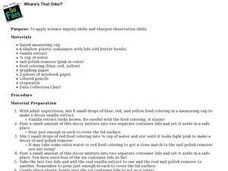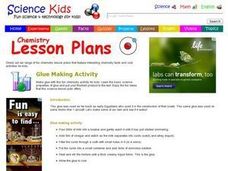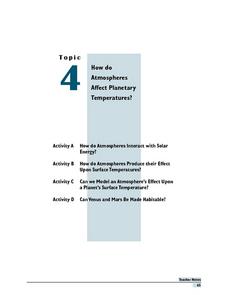Curated OER
Combination of Atoms
In this atoms learning exercise, students review protons, neutrons, electrons, molecules, compounds, and ions. This learning exercise has 10 fill in the blank and 3 problems to solve.
Curated OER
Introduction to Gas Chromatography
Students analyze gas chromatograms and suggest various applications for gas chromatography.
Curated OER
Where's That Odor?
Students use various substances to experiment with odors and their potency. They sharpen their observational skills.
Curated OER
DNA Extraction From Living Things
Learners extract DNA from split peas. In this biology lesson plan, students hypothesize what DNA looks like and perform the experiment to verify their hypothesis. They explain the importance of DNA in living things.
Curated OER
Chemistry: Plastic Milk
Young scholars observe a basic chemical reaction as vinegar is mixed with skim milk and microwaved. First, they listen to the teacher read, "Little Miss Muffet," and discover the meaning of curds and whey. While the experiment have an...
Curated OER
Think Green
Students experience and practice compositing and recycling through hands-on-activities. They distinguish between which items from their trash can be recycled, composted and reused. The process for making recycled paper is also covered in...
Curated OER
Molecular Approaches to Evolution
Young scholars are introduced to working with molecular data. The first activity does both simulated and original data are used to compare amino acid, protein or DNA differences to construct phylogenetic trees or cladograms. These...
Curated OER
Matter
Students complete a unit of activities to learn about states of matter and how to measure matter. In this matter lesson, students complete 8 lessons to learn about matter, its states, and how to measure matter.
Curated OER
From Seed to Bread
Young scholars examine how some of their food comes from plants by baking bread. They listen to teacher read alouds that set the stage for the activity.
Curated OER
Mixing Colors
Fifth graders perform experiments with color mixing and color changing. They observe the differences between physical and chemical changes and record their observations in journals.
Curated OER
Properties of Liquids
Seventh graders explain that liquids are made up of tiny particles and how these spaces allow other particiles to fit in between larger particles. They then plan and carry out simple scientific experiments.
Curated OER
Density
Students work with a partner to record observations on various materials. Working together, they calculate the mass and volume of each material and then combine them and shake them for a period of time. In their journals, they record...
Curated OER
Food and Fiber: Helping the Environment and You
Fourth graders explore the many uses of corn-based products and the importance of water resources. They consider how biodegradable products help to keep water clean. They perform experiments to observe how corn pellets dissolve while...
Curated OER
What type of soil do worms like?- An Investigation
Students study four types of soil and predict which one worms would use for their habitat. They observe worms in each type of soil and monitor their activity. They create class charts highlighting their discoveries.
Curated OER
Acid and Bases - Alien II
Eighth graders determine which of two solutions is more acidic by adding each to a given base. Students have to apply this analysis process to a problem scenario involving an alien creature.
Curated OER
Thin-layer chromatography
Students produce chromatograms of various vegetable extracts and standards. Using a flat bed scanner, they create a database of the results.
Curated OER
Rain Drops
Students examine drops of water on several materials used on the outside of buildings. They make selective observations on and compare plastic, wood, brick, metal, roof tiles and glass.
Curated OER
Glue Making
Students make glue out of milk and vinegar. In this chemistry lesson plan, students combine curds of milk with an ammonia solution until a creamy liquid forms.
Curated OER
How Do Atmospheres Affet Planetary Temperatures?
Students perform a literature search and use reputable research resources in order to find the surface temperature of different planets in our solar system. They speculate about the observed and unobserved factors. Then brainstorming is...
Curated OER
Making Blood
Fifth graders review what they have already gathered about human blood. After reviewing the components of blood, they work together to make their own. Using the internet, they complete a blood web hunt and share their discoveries with...
Curated OER
Coal Flowers
Students observe the effect of various chemicals on coal. Using coal, laundry bluing, water, salt, and ammonia, they observe crystal formations after a period of a few hours, and discuss their observations.
Curated OER
How Does Water Cool?
How fast does water cool? First fifth graders will draw a line on a graph that predicts how fast they think water can cool from boiling. Then they plot the actual data on the same graph to see if their estimate was correct.
Curated OER
Creeping Sheets of Ice
Students conduct scientific investigation in which they observe glacial
effects on landscape, develop and explain their own theories of how glaciers change land, and demonstrate understanding and explain basic motion and force principles.
DiscoverE
Slime!!
Who's going to get slimed? Your entire class! Scholars create slime using Borax, water, and white glue. Some food coloring can give the slime a bit of color.

























